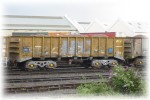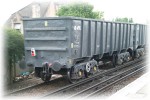 |
Log-in Register Register |
|||||||||||
| RAIL DATA | ||||||||||||

| Title: | PTA/JTA/JUA Bogie Iron-Ore/Stone Tipplers |  |
| Built: | 1971-1977 | |
| Builder: | BREL Shildon (PT001), Redpath Dorman Long | |
| Numbering: | BSSC26000-26106 (PT001), BSTE26450-26563, BSSW26564-26677, BSRV26678-26800 | |
| Running Gear: | BR FBT10 (PT001) or BSC Axle-Motion bogies | |
| Quantity: | 458 | |
| Used: | 1971-current | |
| Icons: |
|
|
| Summary: | Several large batches of these rugged bogie box wagons were built to convey iron-ore from ports to steel works in the 1970s. The changing fortunes of the steel-making industry has seen them lead interesting lives. | |
| Profile: |
The first batch of 107 wagons was built at BR Shildon and was mounted on BR designed FBT10 bogies. Apart from the bogies, this batch differed considerably from the later batches in having regular vertical ribs on the bodysides and ends, slim top-ribs and a distinct solebar. They were put to use on the circuit from Immingham to Scunthorpe. Like the batches that followed, these wagons were designed to be unloaded by passing through a rotating tippler. To enable this, most of the wagons were built as 'inner' vehicles, with a fixed buckeye-type coupling at one end, and a rotating one at the other. A smaller quantity were 'outer' wagons, with conventional draw-gear at one end. Due to the arrangement of the couplings, correct marshalling of vehicles within rakes was critical, and the liveries were designed to ensure this. The first batch wore a dark grey livery with an orange end at the rotating coupling end. The orange was carried round the sides to the first couple of panels.
All of these wagons originally carried the TOPS code of PTA, with design codes of PT001 (for the BREL vehicles) and PT002/003/004 for the remainder. Variations in the design codes (eg PT001B) were used to distinguish the inner and outer vehicles. In the 1990 TOPS code reshuffle, the wagons became either JTA (outers) or JUA (inners).
The second batch of 114 wagons was built from 1972 at British Steel's own Redpath Dorman and Long works in Middlesbrough. Mounted on BSC Axle Motion bogies, these wagons looked quite different, with a beefed-up body, heavier ribs (including horizontal ones on the wagon ends) and no visible solebar. The slight taper of the bodysides on the original batch was retained. This batch entered service between Redcar and Consett steel works but was destined to last less than 10 years. Consett closed in 1981 and the wagons were sold to wagon-hirer Procor. The design was suitable for aggregates traffic and the wagons were overhauled and transferred to the South-East for use by roadstone companies. ARC took 50 which were renumbered PR26801-26850. The remainder were hired to Yeoman and retained their original numbers albeit with PR prefixes. Their use was in block formations from quarries at Merehead, Whatley and Tytherington to depots in London and the home counties. The Yeoman service was for a time the heaviest regular freight train in the UK, 43 of the wagons being hauled by a pair of class-56 diesels from Merehead to Acton where the train was split. The liveries (originally grey/orange like the Scunthorpe batch) were changed to ARC mustard or Yeoman grey.
Another batch of 114 wagons was built in 1974 for the Port Talbot to Llanwern circuit in South Wales. The livery of this batch differed in being dark blue and orange, at least by the 1980s. This service was also notable for its weight, rakes of 27 wagons needed three class 37s, although pairs of 56s were later able to manage 30 wagons. The steel works at Llanwern closed in xxxx and the current uses of this batch are unknown, although the survivors have been recoded with a VTG prefix in place of the original BSSW.
The final batch of 123 wagons arrived from 1977 and they were used from Hunterston on the Clyde estuary to Ravenscraig steelworks. They were also reported to work from quarries at Shap and Thrislington, presumably carrying limestone or dolomites. As with the other batches, these wagons were made redundant when Ravenscraig closed in 1992, and a few were transferred south to bolster the Llanwern fleet. The sturdy and youthful wagons were also suitable for conversion to other types and a total of 56 were rebuilt as covered steel carriers (TOPS code JSA) and renumbered in the range BSSP4020-4099. The conversion also involved fitting of conventional draw-gear at each end. A similar conversion to JSA (although to a distinctly different design) was undertaken on 18 of the ARC batch, these being renumbered from the PR268xx range to CAIB3063-3080.
As of late 2005, the original batch was intact, still operating on its original route. Most of the South Wales fleet were also still in service (somewhere!) but the arduous nature of the roadstone traffic had taken its toll on the ARC and Yeoman fleets, and these were in the process of withdrawal.
|
|
| References: |
|
|
| Links: | N.B. Links will open in a new window. Photos of British Steel Ravenscraig (BSRV) PTA wagons on Paul Bartlett's website Photos of British Steel Llanwern (BSSW) PTA wagons on Paul Bartlett's website Photos of British Steel Scunthorpe (BSSC) PTA wagons on Paul Bartlett's website Photos of ARC operated PTA wagons on Paul Bartlett's website Photos of Yeoman operated PTA wagons on Paul Bartlett's website Photos of JTA wagons on Martyn Read's website Photos of JUA wagons on Martyn Read's website Photos of BSSC-prefixed JTA wagons on Andy Jupe's website Photos of PR-prefixed JTA wagons on Andy Jupe's website Photos of VTG-prefixed JTA wagons on Andy Jupe's website Photos of BSSC-prefixed JUA wagons on Andy Jupe's website Photos of PR-prefixed JUA wagons on Andy Jupe's website Photos of VTG-prefixed JUA wagons on Andy Jupe's website |
|
| Notes: |
No notes have been left yet. ?There may be some notes posted but which have not yet been approved. |
|
| Data tags: ?Tags are mainly intended to show links to relevant profiles when looking at the detail page for TOPS codes, designs, batches etc. Here they work 'backwards' and will take you to the detail pages. |
Batch: BSSC26000-BSSC26094 Batch: BSSC26095-BSSC26099 Batch: BSSC26100-BSSC26104 Batch: BSTE26450-BSTE26541 Batch: BSTE26542-BSTE26552 Batch: BSTE26553-BSTE26563 Batch: BSSW26564-BSSW26665 Batch: BSSW26666-BSSW26671 Batch: BSSW26672-BSSW26677 Batch: BSRV26678-BSRV26778 Batch: BSRV26779-BSRV26789 Batch: BSRV26790-BSRV26800 Batch: PR26801-PR26850 TOPS Class/Code: JTA-E P.O. Ironstone Tippler, bogie, end vehicle, rotary coupling TOPS Class/Code: JTA-F P.O. Ironstone Tippler, bogie, end vehicle, no rotary coupling TOPS Class/Code: JUA-D P.O. Ironstone Tippler, bogie, (42ft. overall length) TOPS Class/Code: PTA-D Bogie Ironstone Tippler, 42ft TOPS Class/Code: PTA-E Bogie Ironstone Tippler - End Vehicle - Rotary Couplings TOPS Class/Code: PTA-F Bogie Ironstone Tippler - End Vehicle |
|
| Added on: | 01/10/2007 | |
| Edits: |
This item has not been edited. |
|



